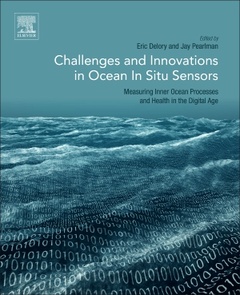Challenges and Innovations in Ocean In Situ Sensors Measuring Inner Ocean Processes and Health in the Digital Age
Coordonnateurs : Delory Eric, Pearlman Jay

Challenges and Innovations in Ocean In-Situ Sensors: Measuring Inner Ocean Processes and Health in the Digital Age highlights collaborations of industry and academia in identifying the key challenges and solutions related to ocean observations. A new generation of sensors is presented that addresses the need for higher reliability (e.g. against biofouling), better integration on platforms in terms of size and communication, and data flow across domains (in-situ, space, etc.). Several developments are showcased using a broad diversity of measuring techniques and technologies. Chapters address different sensors and approaches for measurements, including applications, quality monitoring and initiatives that will guide the need for monitoring.
1. Introduction 2. Ocean in-situ sensors: new developments in biogeochemistry sensors 3. Ocean in-situ sensors: new developments in biological sensors 4. Ocean in-situ sensors: cross-cutting innovations 5. Innovative sensor carriers for cost-effective global ocean sampling 6. From sensor to user – interoperability of sensors and data systems 7. Challenges and approaches to system integration 8. Use Case scenarios - Three different use-cases will be developed
Environmental Scientists, Ocean Scientists, Researchers, environmental managers
Dr Pearlman is currently focused on making oceans observations more cost-effective and reliable along with increasing user access through improved interoperability. His interests include ocean sensors and systems, ocean research interoperability and information systems. Jay is PI on the five-year NSF OceanObs Research Coordination Network and a Co-PI on NSF’s EarthCube/BCube project. He is a work package co-lead for the European FP7 ocean sensor research project, NeXOS, the Atlantic ocean observation project, AtlantOS and was work package lead on EuroGEOSS, developing an information broker capability for GEOSS. He currently co-chairs the EarthCube Technology and Architecture Committee
- Integrates information across key marine and maritime sectors and supports regional policy requirements on monitoring programs
- Offers tactics for enabling early detection and more effective monitoring of the marine environment and implementation of appropriate management actions
- Presents new technologies driving the next generation of sensors, allowing readers to understand new capabilities for monitoring and opportunities for another generation of sensors
- Includes a global vision for ocean monitoring that fosters a new perspective on the direction of ocean measurements
Date de parution : 09-2018
Ouvrage de 408 p.
21.4x27.6 cm
Thèmes de Challenges and Innovations in Ocean In Situ Sensors :
Mots-clés :
Education and outreach; Fluorometers; Slocum gliders; Storms


